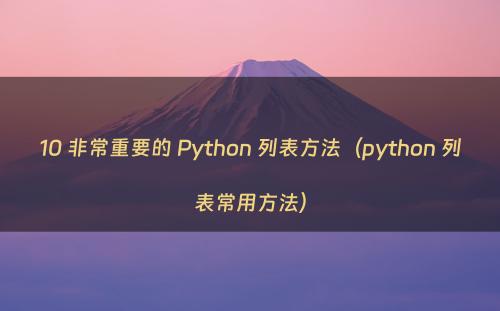网站首页 > 基础教程 正文
Python 列表是可变的或可更改的数据类型。与不可变或不可更改的字符串数据类型不同,每次我们在列表上使用一个方法时,我们都会影响列表本身,而不是列表的副本。这里有十个非常重要的 Python 列表方法,你应该熟悉:

- append():此方法将项目添加到列表的末尾。例如:
numbers = [1, 2, 3]
numbers.append(4)
print(numbers) # Output: [1, 2, 3, 4]- extend():此方法将多个项目添加到列表的末尾。例如:
numbers = [1, 2, 3]
numbers.extend([4, 5, 6])
print(numbers) # Output: [1, 2, 3, 4, 5, 6]- insert():此方法在列表中的特定位置插入一个项目。例如:
numbers = [1, 2, 3]
numbers.insert(1, 10)
print(numbers) # Output: [1, 10, 2, 3]- remove():此方法从列表中删除特定项的第一个出现。例如:
numbers = [1, 2, 3, 2, 4]
numbers.remove(2)
print(numbers) # Output: [1, 3, 2, 4]- pop():此方法从列表中删除并返回指定位置的项。如果没有指定位置,则删除并返回最后一个项。例如:
numbers = [1, 2, 3]
x = numbers.pop(1)
print(x) # Output: 2
print(numbers) # Output: [1, 3]- index():此方法返回列表中特定项首次出现的位置。例如:
numbers = [1, 2, 3, 2, 4]
x = numbers.index(2)
print(x) # Output: 1- count():此方法返回列表中特定项出现的次数。例如:
numbers = [1, 2, 3, 2, 4]
x = numbers.count(2)
print(x) # Output: 28.sort():此方法按升序对列表中的项目进行排序。例如:
numbers = [3, 1, 4, 2]
numbers.sort()
print(numbers) # Output: [1, 2, 3, 4]- reverse():此方法反转列表中项的顺序。例如:
numbers = [1, 2, 3, 4]
numbers.reverse()
print(numbers) # Output: [4, 3, 2, 1]- copy():此方法创建列表的副本。如果您想在不对原始列表进行修改的情况下更改列表,这很有用。例如:
numbers = [1, 2, 3, 4]
new_numbers = numbers.copy()
new_这些方法允许你在列表中添加、删除和操作项目,以及执行排序和反转项目顺序等操作。了解如何有效地使用这些方法可以帮助你在 Python 项目中更高效、更有效地处理列表。
猜你喜欢
- 2025-03-24 10个非常重要的Python列表方法(python的列表怎么用)
- 2025-03-24 Python编程入门:基本数据类型之列表
- 2025-03-24 python序列之列表详解(python序列类型及运算)
- 2025-03-24 一文掌握在Python列表中添加元素的多种方法
- 2025-03-24 Python 基础教程三之Python3 列表
- 2025-03-24 Python的数据结构详解一(列表)(python数据结构教程)
- 2025-03-24 5-4-Python数据类型-列表(python中6种数据类型)
- 2025-03-24 Python 列表:从入门到高阶,避坑 + 性能优化全攻略
- 2025-03-24 python数据容器之列表、元组、字符串
- 2025-03-24 掌握 Python 列表:综合指南(python入门之玩转列表)
- 最近发表
- 标签列表
-
- jsp (69)
- pythonlist (60)
- gitpush (78)
- gitreset (66)
- python字典 (67)
- dockercp (63)
- gitclone命令 (63)
- dockersave (62)
- linux命令大全 (65)
- mysql教程 (60)
- pythonif (86)
- location.href (69)
- deletesql (62)
- c++模板 (62)
- linuxgzip (68)
- 字符串连接 (73)
- nginx配置文件详解 (61)
- html标签 (69)
- c++初始化列表 (64)
- mysqlinnodbmyisam区别 (63)
- arraylistadd (66)
- console.table (62)
- mysqldatesub函数 (63)
- window10java环境变量设置 (66)
- c++虚函数和纯虚函数的区别 (66)
